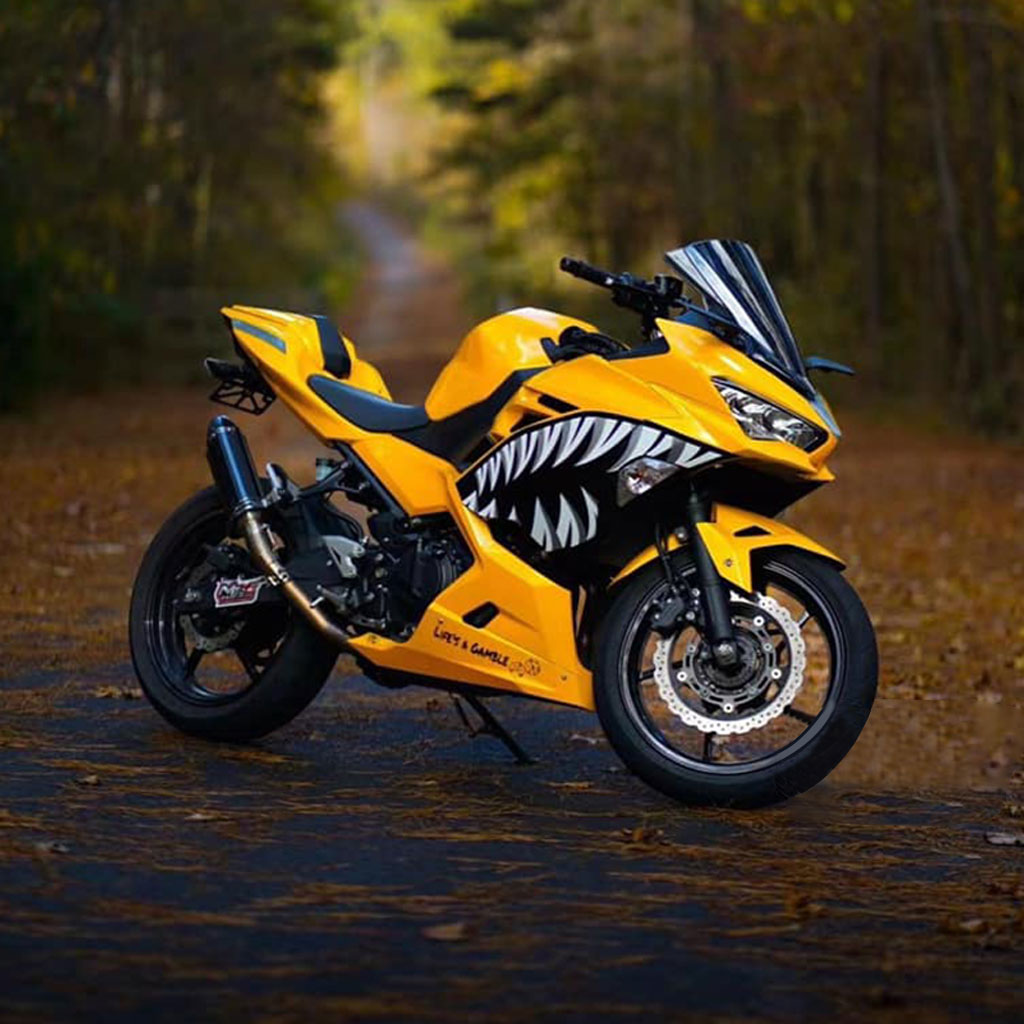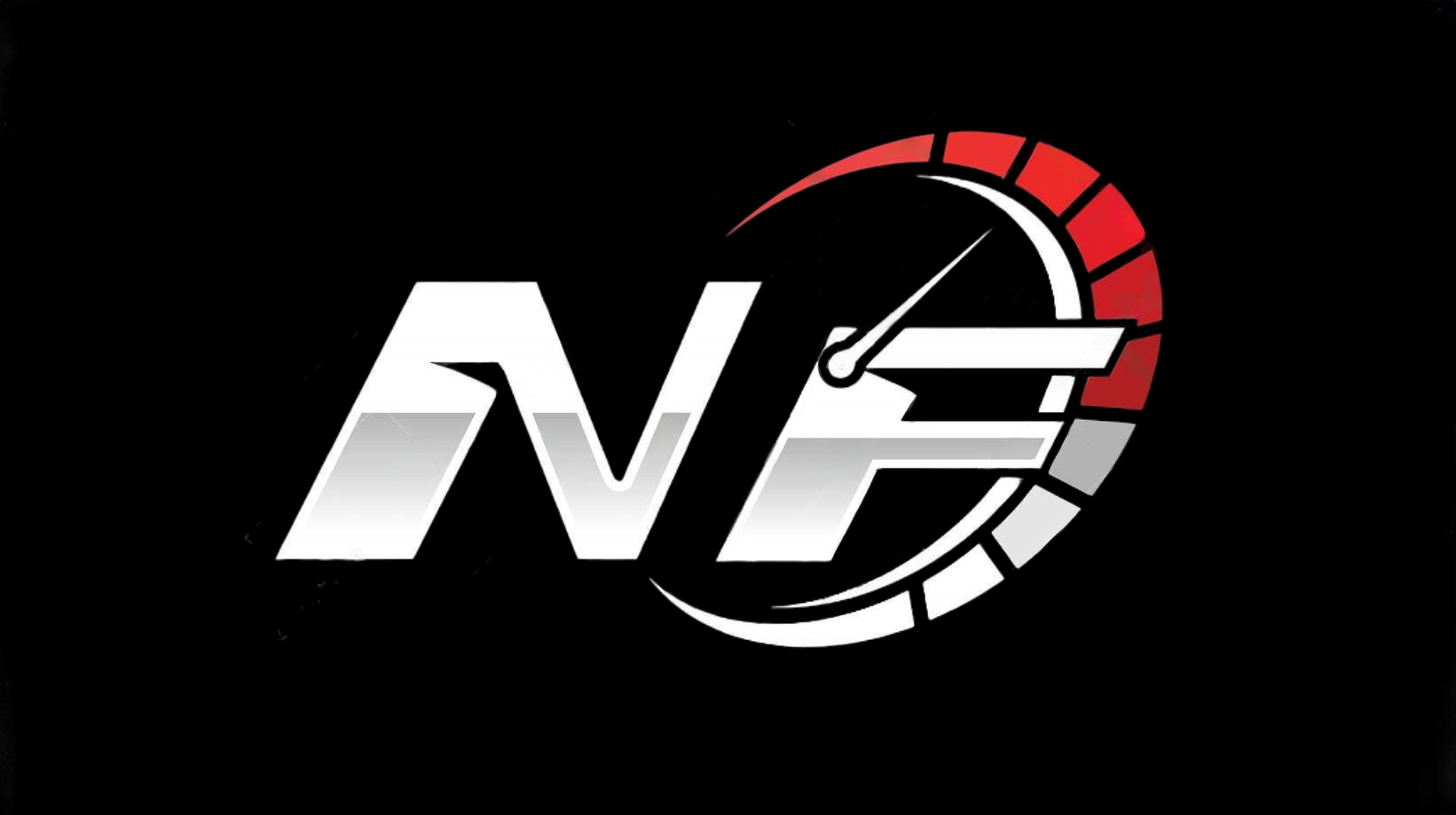Ninja 650 Versus Other Ninjas Which Model Fits You Best
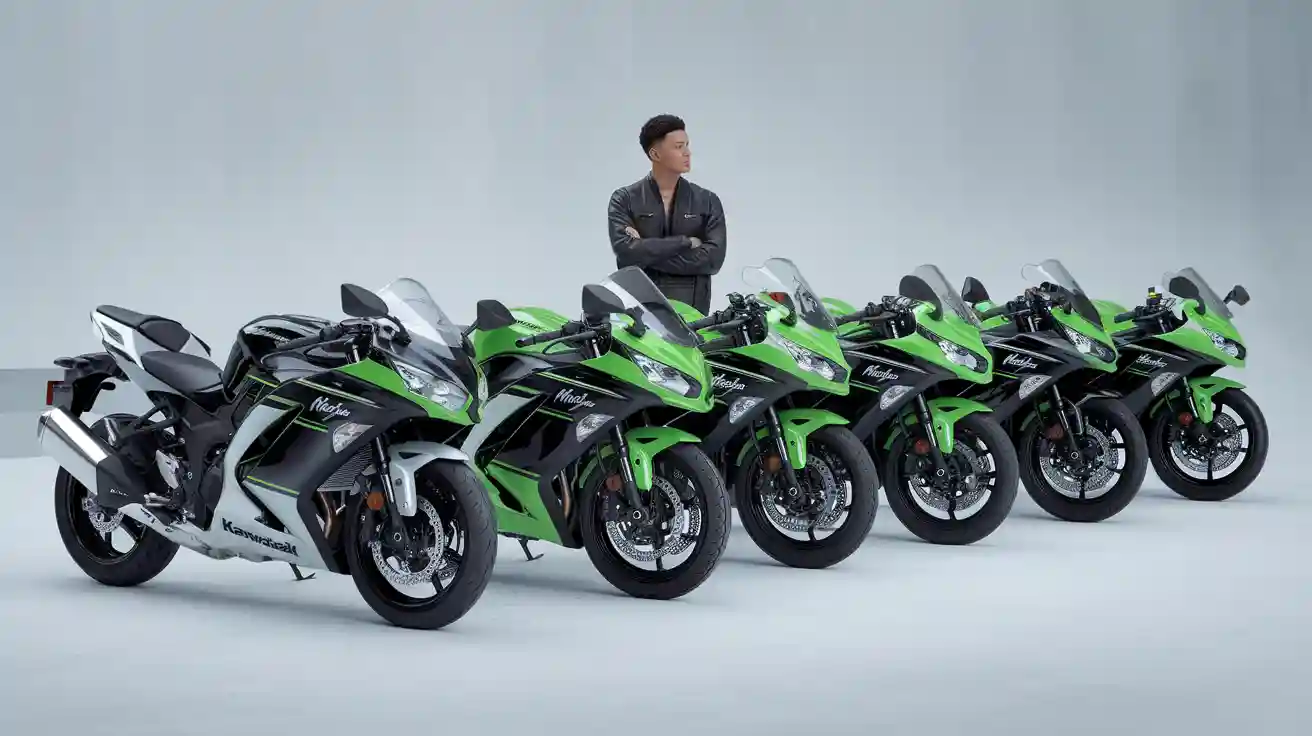
Choosing your perfect Kawasaki starts with your needs as a rider. If you want a motorcycle that blends comfort and excitement, the ninja 650 ninja stands out. Many riders find the ninja 650 ninja offers just the right mix for daily rides and weekend adventures. Kawasaki designed each ninja model for different goals. Some kawasaki bikes focus on new riders, while others aim for the thrill of maximum power.
Ninja 650 Ninja: Balanced Performance for Everyday Riders
Engine and Performance
You get a strong and smooth ride with the ninja 650 ninja. This midsized sport bike uses a 649cc parallel-twin engine. It gives you quick acceleration and steady power for city streets or highways. The engine produces 68 horsepower at 8,000 rpm and 47.2 lb-ft of torque. You can reach a top speed of about 200 km/h. The table below shows the main engine specs:
| Specification | Value | Unit | RPM/Speed |
|---|---|---|---|
| Horsepower | 68 | hp | 8,000 rpm |
| Torque | 47.2 | lb-ft | 7,250 rpm |
| Top Speed | 200 | km/h | N/A |
This mid-sized motorcycle gives you enough performance for daily rides and weekend trips. You feel confident on twisty roads and in traffic.
Key Features
You will find many features that make the ninja 650 ninja stand out in the kawasaki lineup:
- Kawasaki Traction Control (KTRC) with two modes and an OFF option
- Lightweight trellis frame for easy handling
- Twin LED headlights for better visibility
- Digital TFT color display with smartphone connectivity using RIDEOLOGY THE APP
- Dunlop Sportmax Roadsport 2 tires for a sporty ride
- Redesigned windshield for better wind protection
- Thicker rear seat for more passenger comfort
Tip: You can add options like a single seat cover, touring windscreen, or a 12V power outlet to match your needs.
These features help you enjoy every ride, whether you use your ninja 650 for commuting or fun.
Ideal Rider Profile
The ninja 650 ninja fits many types of riders. You may like this kawasaki if you want a balance between comfort and sporty fun. Recent sales data show that 60% of buyers are male and 40% are female. Most owners are between 25 and 34 years old.
| Demographic Aspect | Percentage |
|---|---|
| Male Buyers | 60% |
| Female Buyers | 40% |
| Largest Age Group (25-34 yrs) | 45% |
You may choose the ninja 650 if you want a reliable, stylish, and easy-to-handle ninja. It works well for new riders moving up or experienced riders who want a practical bike.
Ninja 400: Entry-Level Ninja for New Riders
Engine and Performance
You will find the ninja 400 stands out as one of the best sports bikes for beginner riders. This entry-level ride uses a 399 cc parallel-twin engine. It delivers smooth power and quick response, which helps you build confidence on the road. The engine produces up to 49 horsepower at around 10,000 rpm and 28 lb-ft of torque at about 8,000 rpm. These numbers give you enough speed for city rides and highway trips.
| Specification | Value |
|---|---|
| Engine Displacement | 399 cc |
| Horsepower | 49 hp @ ~10,000 rpm |
| Torque | 28 lb-ft @ ~8,000 rpm |
The ninja 400 weighs only 366 pounds with a seat height of 30.9 inches. This makes it lighter and easier to handle than many other entry-level sport bikes. You will notice the bike feels stable and easy to control, even if you are new to riding.
Key Features
Kawasaki designed the ninja 400 with features that help you feel safe and comfortable. You get front and rear disc brakes with standard ABS, which help prevent wheel lockup during hard stops. The fully digital LCD instrument panel shows your speed, RPM, fuel level, and gear position. The assist and slipper clutch makes shifting smoother and reduces the effort needed to pull the clutch lever. Twin LED headlamps improve your visibility, especially at night.
| Feature Category | Feature Description |
|---|---|
| Safety | Front and rear disc brakes with ABS for better control |
| Technology | Digital LCD display with speed, RPM, fuel, and gear indicators |
| Clutch System | Assist and slipper clutch for easier shifting |
| Lighting | Twin LED headlamps for brighter visibility |
| Fuel Efficiency | Economical Riding Indicator to help you save fuel |
Note: The ninja 400’s lighter weight and lower seat height make it a great choice for smaller or shorter riders.
Ideal Rider Profile
You should consider the ninja 400 if you want an entry-level ride that is easy to manage and fun to ride. This kawasaki model fits new riders who want to learn on a forgiving bike. Many riders choose the ninja 400 as their first motorcycle because it offers a good mix of power, safety, and comfort. If you want a bike that helps you grow your skills and gives you confidence, the ninja 400 could be your best option in the entry-level category.
Ninja ZX-6R: Supersport for Experienced Enthusiasts
Engine and Performance
You will notice the Ninja ZX-6R stands out in the supersport class. This kawasaki uses a liquid-cooled, inline 4-cylinder engine. The engine size is either 599 cc or 636 cc, depending on the model year. You get up to 135 horsepower with ram air at 13,500 rpm. The torque reaches about 60-65 Nm at 11,000-11,500 rpm. The top speed can hit 250 km/h. The table below shows the main engine and braking specs:
| Specification | Details |
|---|---|
| Engine Type | Liquid-cooled, DOHC, 4-valve, inline 4-cylinder |
| Displacement | 599 cc or 636 cc |
| Peak Power | Up to 135 hp @ 13,500 rpm (with ram air) |
| Torque | 60-65 Nm @ 11,000-11,500 rpm |
| Top Speed | 250 km/h |
| Transmission | Manual, chain drive |
| Front Brake Diameter | 275 mm |
| Rear Brake Diameter | 220 mm |
You get strong acceleration and smooth power delivery. The 636 cc engine gives you more torque than other bikes like the Yamaha R6. This helps you get better mid-range acceleration. The advanced braking system and Showa suspension give you control on both street and track.
Key Features
Kawasaki gives you many advanced features on the Ninja ZX-6R. You get a 4.3-inch full-color TFT display with smartphone connectivity. The bike has Kawasaki Traction Control (KTRC) with three levels. You can choose from Sport, Road, Rain, or Manual riding modes. The selectable power modes let you adjust the bike for different situations. The Kawasaki Quick Shifter (KQS) allows clutchless upshifts. The assist and slipper clutch helps you shift smoothly and reduces back-torque. The advanced braking system uses radial-mounted monobloc calipers and a radial-pump master cylinder. You also get all-LED lighting and Pirelli Diablo Rosso IV tires.
- 4.3-inch TFT display with smartphone connection
- Multiple traction control and power modes
- Quick shifter for fast gear changes
- Adjustable Showa SFF-BP fork suspension
- Kawasaki Intelligent anti-lock Brake System (KIBS)
- All-LED lighting for better visibility
Tip: These features help you ride with confidence on the street and at the track.
Ideal Rider Profile
You should consider the Ninja ZX-6R if you have experience riding smaller motorcycles. Many owners start with bikes like the Ninja 250 before moving up. The ZX-6R fits intermediate to advanced riders. You will enjoy this kawasaki if you want sporty handling and strong performance. The aggressive riding position suits riders who love sport riding. The adjustable suspension and quick shifter appeal to those who want to customize their ride. The bike is less comfortable for long trips, so it works best for those who focus on sport riding and track days.
- You have prior riding experience.
- You want a bike for sport riding, not casual commuting.
- You value advanced features and strong acceleration.
- You seek a motorcycle that blends street and track capability.
Ninja ZX-10R: Track-Ready Powerhouse
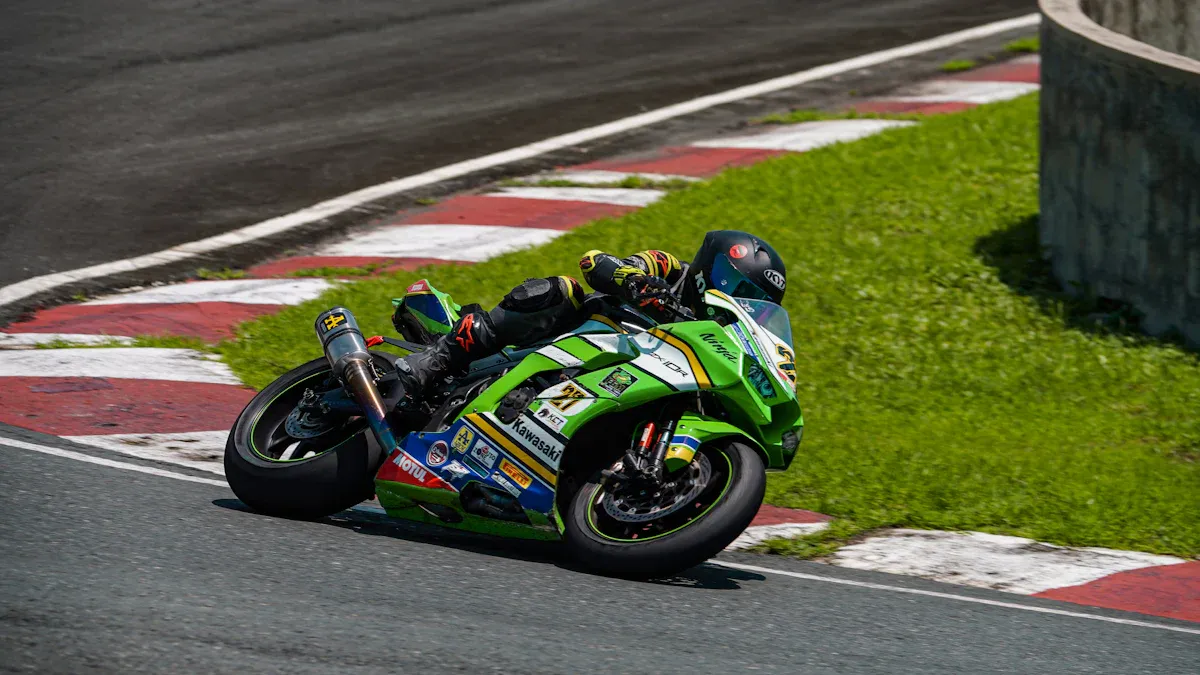
Engine and Performance
You will find the Ninja ZX-10R stands out as a true superbike. The 998 cc inline four-cylinder engine delivers about 175 horsepower at the rear wheel. This power comes alive above 11,000 rpm, giving you a thrilling rush at high speeds. The bike can reach a top speed of nearly 189 mph (about 304 km/h). You can accelerate from 0 to 60 mph in just under 3 seconds. The long gearing helps you on the racetrack, but you may notice less punch at lower speeds. Here is a quick look at the main performance numbers:
| Specification | Value |
|---|---|
| Engine Displacement | 998 cc |
| Peak Horsepower | 175 hp @ >11,000 rpm |
| Top Speed | 188.9 mph (304 km/h) |
| 0-60 mph | 2.91 seconds |
| 1/4 Mile | 9.98 seconds @ 151 mph |
Note: The Ninja ZX-10R’s engine and gearing make it a favorite for high-speed track riding.
Key Features
You get many high-performance features with the Kawasaki Ninja ZX-10R. The engine uses a special triangular layout to keep it compact and light. Forged pistons and a one-piece cylinder help boost power and strength. The cooling system uses both liquid and oil cooling to keep temperatures low during hard riding. The clutch has a back-torque limiter, which helps you stay stable when you downshift quickly.
The suspension uses a Showa Big Piston Fork in the front and a horizontal rear setup for better handling. Later models add electronic steering dampers for extra control. The wheels are lightweight, almost as light as race wheels. The electronics suite includes Sport Kawasaki Traction Control (S-KTRC) and Kawasaki Intelligent Braking System (KIBS) ABS. These systems help you ride faster and safer.
| Feature Category | High-Performance Features |
|---|---|
| Engine Design | Compact triangular layout, forged pistons, one-piece cylinder/crankcase |
| Cooling System | Liquid cooling, oil cooler, special oil pan design |
| Clutch & Transmission | Slipper clutch with back-torque limiter, close-ratio 6-speed gearbox |
| Suspension | Showa Big Piston Fork, horizontal rear suspension, electronic steering damper (later models) |
| Wheels | Lightweight six-spoke or three-spoke wheels |
| Electronics | S-KTRC traction control, KIBS ABS, advanced ECU and IMU |
| Chassis | Short wheelbase, high power-to-weight ratio |
Ideal Rider Profile
You should consider the Ninja ZX-10R if you want a bike built for speed and track performance. Kawasaki designed this model for young, ambitious riders who crave high performance. The marketing highlights its racing roots and exclusivity, making it popular among those who want to feel connected to the brand’s racing legacy. You will see many professional racers and serious track day riders choose this bike for its stability and advanced electronics.
- You want top-level speed and power.
- You enjoy track days or competitive riding.
- You value advanced electronics and stability at high speeds.
- You seek a connection to Kawasaki’s racing heritage.
- You like being part of a strong, loyal community of ninja fans.
Tip: The Ninja ZX-10R rewards skilled riders who want to push their limits on the track.
Ninja H2: Ultimate Performance in the Ninja Lineup
Engine and Performance
You will find the Ninja H2 at the top of the Kawasaki lineup. This motorcycle uses a 998 cc inline-four engine with a special supercharger. The supercharger uses a two-speed centrifugal design, which helps the engine make more power without getting too hot. You get 239.6 horsepower at 11,500 rpm and 104.9 lb-ft of torque at 11,000 rpm. The engine uses a 4-stroke, DOHC, 16-valve setup. This design gives you strong acceleration and high top speed.
| Specification | Details |
|---|---|
| Horsepower (2025) | 239.6 hp @ 11,500 rpm |
| Torque (2025) | 104.9 lb-ft @ 11,000 rpm |
| Engine Displacement | 998 cc inline-4 |
| Supercharger Type | Two-speed centrifugal, gear-driven |
| Fuel System | DFI® with 50mm throttle bodies, dual injection |
The Ninja H2 can reach 60 mph in under 3 seconds. It can go from 0 to 200 mph in just 16.83 seconds. The top speed is 212 mph, which is much higher than most other performance motorcycles. You can see how the Ninja H2R compares to other hyperbikes in the chart below.
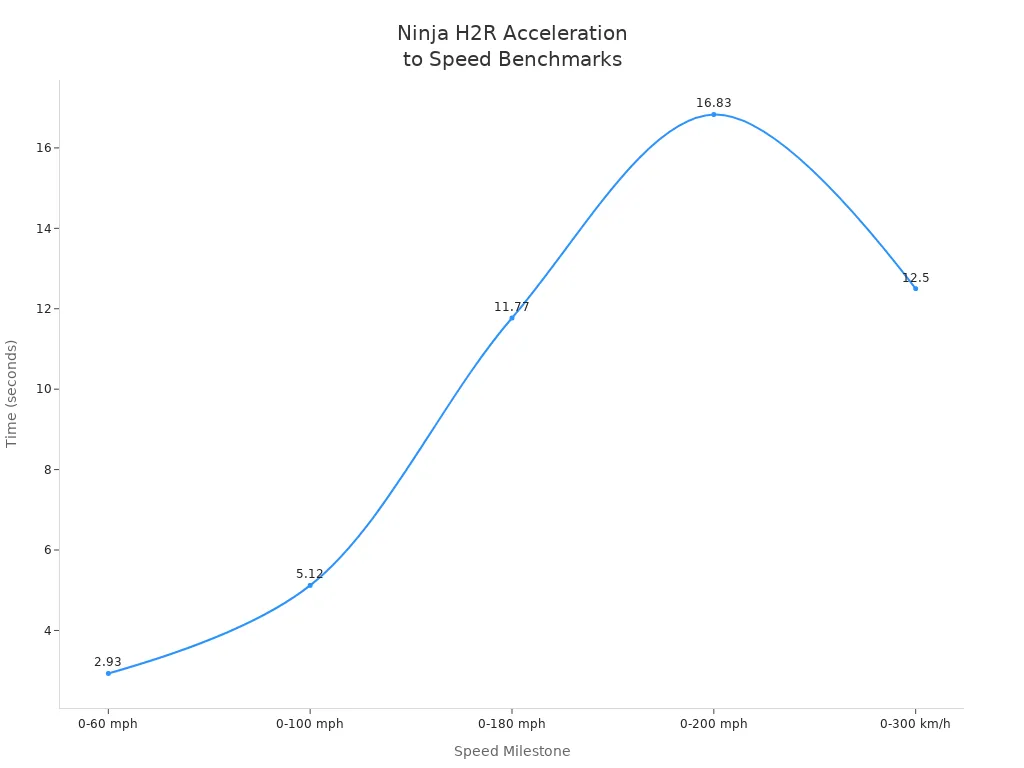
Key Features
You get many advanced features on the Ninja H2. Kawasaki gives you a balanced supercharged engine for unmatched acceleration. The Bosch radar-based ARAS system adds safety with adaptive cruise control, blind-spot detection, and forward collision warning. The FI-ECU with torque-demand control helps you manage engine output. The 6 degrees of freedom IMU improves stability and control. The boost-circuit ABS works with the engine for better braking. Vehicle Hold Assist keeps the bike steady when stopped. The Kawasaki SPIN infotainment system connects your smartphone to the 6.5-inch TFT display. You also get a keyless start system and tire pressure monitoring.
| Exclusive Feature / Technology | Description |
|---|---|
| Bosch ARAS System | Radar-based safety features for traffic and highway riding |
| FI-ECU with Torque-Demand | Precise engine output control for smooth riding |
| 6 DOF IMU | Advanced stability and traction control |
| Boost-Circuit ABS | Enhanced braking with engine coordination |
| Kawasaki SPIN Infotainment | Smartphone integration with TFT display |
Tip: These features make the Ninja H2 one of the most advanced performance motorcycles you can ride.
Ideal Rider Profile
You should choose the Ninja H2 if you want the highest level of speed and technology. This bike fits experienced riders who want to explore the limits of acceleration and top speed. You may enjoy the Ninja H2 if you ride on highways or closed tracks and want the latest safety and infotainment features. The advanced systems help you stay in control, even at high speeds. If you want a motorcycle that stands out for both power and innovation, the Ninja H2 is the best choice in the Kawasaki ninja family.
Side-by-Side Ninja 650 Comparison
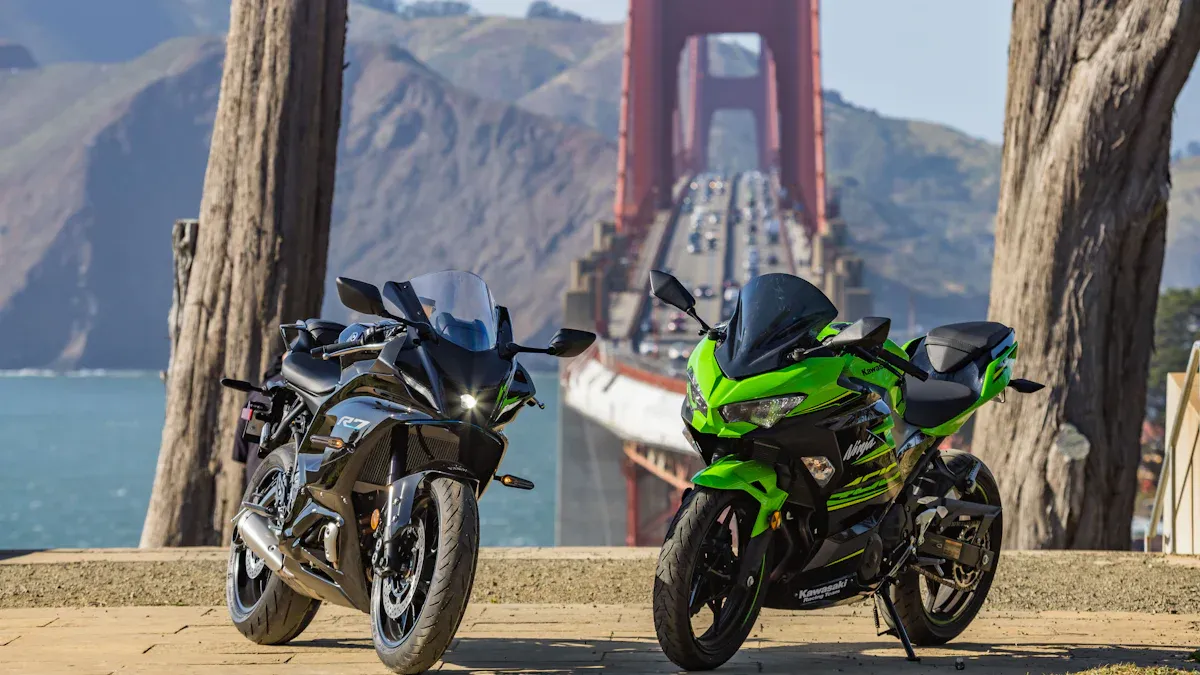
Engine Specs Table
You can see how the Ninja 650 compares to other popular models by looking at their engine specifications. This table shows the main differences in engine size, horsepower, torque, top speed, acceleration, weight, seat height, and fuel economy. These numbers help you understand which bike fits your needs best.
| Feature/Metric | Ninja 300 | Ninja 400 | Ninja 650 |
|---|---|---|---|
| Engine Displacement | 296 cc parallel-twin | 399 cc parallel-twin | 649 cc parallel-twin |
| Horsepower | ~39 hp @ 11,000 rpm | ~45 hp @ 10,000 rpm | ~67 hp @ 8,000 rpm |
| Torque | 27 Nm @ 10,000 rpm | 38 Nm @ 8,000 rpm | 64 Nm @ 6,700 rpm |
| Top Speed | ~175 km/h (109 mph) | ~190 km/h (118 mph) | ~212 km/h (132 mph) |
| 0–100 km/h Acceleration | ~7 seconds | ~5 seconds | ~4 seconds |
| Weight (wet) | ~174 kg (385 lbs) | ~168 kg (370 lbs) | ~193 kg (425 lbs) |
| Seat Height | 785 mm (30.9 in) | 785 mm (30.9 in) | 790 mm (31.1 in) |
| Fuel Economy | ~60–70 mpg | ~60–70 mpg | ~50–60 mpg |
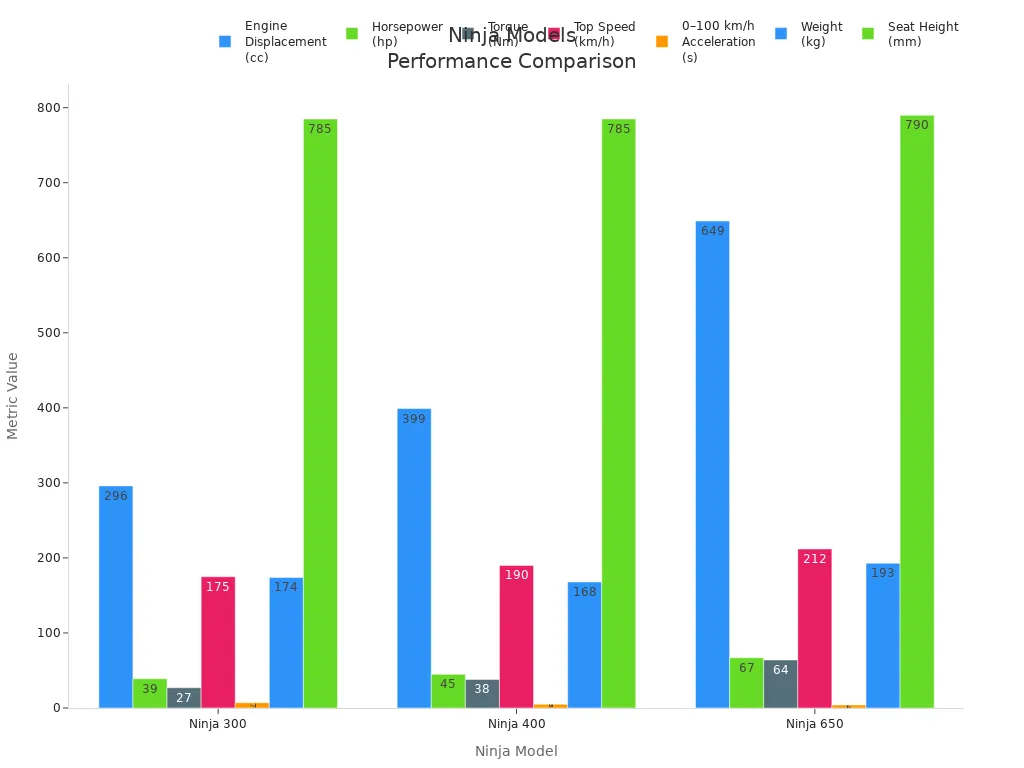
You notice that the Ninja 650 has the largest engine and the most power. It also weighs more than the smaller models. The Ninja 400 sits in the middle, offering a good balance of power and weight. The Ninja 300 is the lightest and easiest to handle, but it has the least power.
Performance and Features Table
When you compare features, you see clear differences in comfort, technology, and riding style. The Ninja 650 stands out with advanced technology and comfort upgrades. The table below highlights the main features and how they affect your ride.
| Feature/Aspect | Ninja 300 | Ninja 400 | Ninja 650 |
|---|---|---|---|
| Handling Style | Light, neutral, soft suspension | Agile, sharper, more planted | Stable, smooth, more effort |
| Comfort Level | Upright, easy for short riders | Sportier, beginner-friendly | Most relaxed, more room |
| Commuting Suitability | Excellent for short urban trips | Great for city and light highway | Ideal for longer/highway commutes |
| Weekend Riding | Fun, forgiving, confidence-building | Balanced speed and agility | Good for touring and spirited roads |
| Track Performance | Basic, limited power | Capable, popular in lightweight racing | Fast in straights, heavier in corners |
| Touring Potential | Limited by comfort and power | Light touring possible | Best for longer rides, two-up |
| Beginner-Friendly? | Yes – perfect first bike | Yes – ideal all-round beginner | Maybe – good for mature beginners |
| Typical Price (New) | N/A (used only) | ~$5,500 – $6,000 | ~$7,400 – $8,000 |
| Maintenance Cost | Very low | Low | Moderate |
| Reliability Score | High (post-2014 models) | Excellent – 5/5 | Excellent – proven engine |
| Advanced Features | Basic dash, halogen lights | LCD display, LED lights, ABS | TFT display, LED lights, KTRC, Bluetooth, improved seat, windscreen |
Note: The Ninja 650 offers a high-tech TFT color display, traction control, and smartphone connectivity. You get more comfort with a thicker seat and better wind protection. These features make it a top choice for riders who want more than just basic transportation.
Rider Experience and Intended Use Table
You should think about how you plan to use your motorcycle. Each model fits a different type of rider and riding style. The table below helps you match your experience and needs to the right bike.
| Rider Experience / Use Case | Ninja 300 | Ninja 400 | Ninja 650 |
|---|---|---|---|
| Best For | First-time riders, city use | New riders, city/highway mix | Experienced beginners, commuters |
| City Riding | Very easy, light, forgiving | Easy, agile, stable | Stable, needs more skill |
| Highway Riding | Possible, less power | Good, enough power | Excellent, strong acceleration |
| Weekend Fun | Yes, confidence-building | Yes, agile and fun | Yes, relaxed touring possible |
| Track Days | Limited, basic learner | Popular in lightweight racing | Fast, but heavier in corners |
| Touring/Long Trips | Not ideal, limited comfort | Possible with soft luggage | Best suited, more comfort |
| Rider Size | Smaller riders | Most riders | Larger/taller riders |
| Aggressive Sport Riding | Not recommended | Possible, but limited | Less aggressive, more relaxed |
| Advanced Rider Aids | None | ABS, LCD, assist clutch | Traction control, TFT, Bluetooth |
- If you are new to riding, the Ninja 300 or 400 gives you a forgiving and easy start.
- If you want more power and comfort for daily commuting or longer trips, the Ninja 650 fits your needs.
- If you plan to ride mostly in the city, the lighter models feel easier to handle.
- For highway travel or two-up touring, the Ninja 650 offers more comfort and stability.
Tip: Always match your bike to your skill level and riding goals. A comfortable and safe ride helps you enjoy every journey.
How to Choose Your Ninja 650 Ninja or Other Model
Assessing Your Experience Level
You should start by thinking about your riding experience. If you are new to motorcycles, you may feel more comfortable on a lighter bike like the Ninja 400. This model offers easy handling and a forgiving ride. If you have some experience, the Ninja 650 gives you more power and stability. Riders with advanced skills often choose the ZX-6R, ZX-10R, or H2 for their high performance. Always match your bike to your current skill level. This helps you stay safe and enjoy your rides.
Tip: Regular maintenance, like checking your chain alignment, keeps your bike reliable and smooth. Many riders notice better throttle response and less engine braking after a simple adjustment.
Defining Your Riding Goals
You should decide what you want from your motorcycle. Some riders want a bike for daily commuting. Others look for weekend fun or track days. Your goals shape your best choice.
- If you want a bike for city rides and learning, pick a Ninja 400.
- If you plan to commute and take longer trips, the Ninja 650 fits well.
- If you dream of racing or track days, look at the ZX-6R or ZX-10R.
- If you crave the most power and technology, the Ninja H2 stands out.
Think about where you will ride most and how you want to feel on your bike.
Matching Features to Your Needs
Each Ninja model offers features for different riders. You can choose upgrades to match your style and needs.
- Upgrading the exhaust system boosts power and sound for performance fans.
- Engine tuning and performance air filters help riders who want faster acceleration.
- Adjustable suspension and high-performance tires improve handling for aggressive riders.
- Optimizing gear ratios lets you tailor speed and acceleration to your style.
A focus on regular maintenance ensures safety and reliability for every rider. You can pick features and upgrades that fit your goals, whether you want comfort, speed, or control. Your perfect Ninja should match your experience, your goals, and the features you value most.
You have many Ninja models to choose from. Each one fits a different rider and style. Use the table below to see which bike matches your needs. Think about comfort, performance, budget, and your experience before you decide.
| Model | Pros | Cons | Best For |
|---|---|---|---|
| Ninja 400 | Light, stylish, easy to handle, good fuel economy | Small passenger seat, limited load | Beginners, city, touring |
| Ninja 300 | Upright, smooth clutch, good for highways | Heavier than Ninja 250R | Intermediate, commuters |
| Ninja 250R | Very light, easy for new riders | Less power, less comfort | Absolute beginners |
Tip: Pick the Ninja that matches your skill and riding goals for the best experience.
FAQ
What makes the Ninja 650 a good choice for daily riding?
You get a comfortable seat, upright handlebars, and smooth power delivery. The Ninja 650 works well for city commutes and highway trips. You can enjoy both short and long rides without feeling tired.
Can a beginner handle the Ninja 650?
You can ride the Ninja 650 as a beginner if you feel confident and have basic skills. The bike offers friendly power and easy handling. Many new riders start with the Ninja 400, then move up to the 650.
How does the Ninja 400 compare to the Ninja 650 for fuel economy?
You will notice better fuel economy on the Ninja 400. The Ninja 400 averages 60–70 mpg. The Ninja 650 usually gets 50–60 mpg. If you want to save on gas, the Ninja 400 is the better pick.
Which Ninja model is best for track days?
You should look at the Ninja ZX-6R or ZX-10R for track days. These bikes give you advanced suspension, high power, and racing features. The Ninja 650 can go to the track, but it focuses more on comfort and daily use.
What safety features do Ninja models offer?
You get ABS brakes, traction control, and LED lighting on most new Ninja models. Some bikes, like the Ninja H2, add radar-based safety systems. These features help you stay safe in many riding conditions.
See Also
Comparing OEM And Aftermarket Fairings For Ninja 500
Detailed Analysis Of Ninja 650 Kawasaki Fairing Performance
Top Six Stylish Motorcycles Perfect For New Riders 2025
